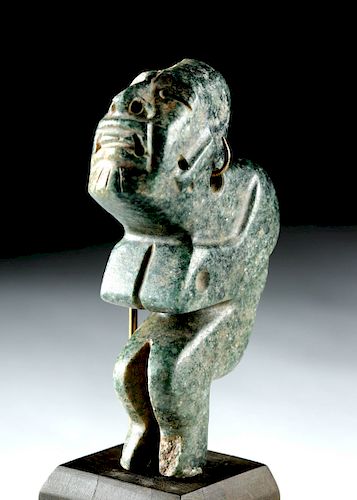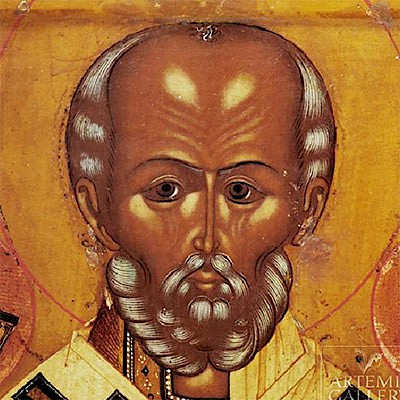Important Olmec Jadeite Hunchback Figure
Lot 128c
About Seller
Artemis Fine Arts
686 S Taylor Ave, Ste 106
Louisville, CO 80027
United States
Selling antiquities, ancient and ethnographic art online since 1993, Artemis Gallery specializes in Classical Antiquities (Egyptian, Greek, Roman, Near Eastern), Asian, Pre-Columbian, African / Tribal / Oceanographic art. Our extensive inventory includes pottery, stone, metal, wood, glass and textil...Read more
Estimate:
$6,000 - $9,000
Absentee vs Live bid
Two ways to bid:
- Leave a max absentee bid and the platform will bid on your behalf up to your maximum bid during the live auction.
- Bid live during the auction and your bids will be submitted real-time to the auctioneer.
Bid Increments
| Price | Bid Increment |
|---|---|
| $0 | $25 |
| $300 | $50 |
| $1,000 | $100 |
| $2,000 | $250 |
| $5,000 | $500 |
| $10,000 | $1,000 |
| $20,000 | $2,500 |
| $50,000 | $5,000 |
| $100,000 | $10,000 |
| $200,000 | $20,000 |
About Auction
By Artemis Fine Arts
Dec 20, 2018
Set Reminder
2018-12-20 10:00:00
2018-12-20 10:00:00
America/New_York
Bidsquare
Bidsquare : Warehouse Clear Out - Ancient & Ethnographic
https://www.bidsquare.com/auctions/artemis-gallery/warehouse-clear-out---ancient-ethnographic-3742
Time to clear out the warehouse, as these lots are going, going, gone... plus a we've added a nice selection of lots brand-new to auction! Artemis Fine Arts info@artemisgallery.com
Time to clear out the warehouse, as these lots are going, going, gone... plus a we've added a nice selection of lots brand-new to auction! Artemis Fine Arts info@artemisgallery.com
- Lot Description
**First Time At Auction**
Pre-Columbian, Southern Mexico / Guatemala, Olmec, ca. 1150 to 500 BCE. An expertly carved jadeite statue carved in the round - depicting a hunchback figure, perhaps a shaman, crouching in profile , with arms clasped to the chest and knees bent, a characteristically elongated head presenting fabulous string-cut facial features, and two biconically drilled perforations through the ears for inserting decorative ornaments or suspending the figure. The figure presents a classic Olmec baby visage with jowly cheeks, slit eyes, a relatively naturalistic nose with partially pierced nostrils, and a were-jaguar mouth. Finally, the inherent beauty of the stone with its blue-green hues, makes this piece more than impressive. Size: 4.375" H (11.1 cm); 6" H (15.2 cm) on included custom stand.
The sculptor of this piece brilliantly captured the dramatic hunchback form, with that pronounced physiognomic deformity and compromised position. Scholars have theorized that in the Pre-Columbian world deformities such as hunchbacks were regarded as signs that these individuals were special, touched by the deities, and as such they were oftentimes chosen to be shaman. In addition to this meaningful iconography, the skillful workmanship and the inherent beauty of the jade with its brilliant blue-green hues make this piece very impressive.
The first major civilization in Meso-America was that of the Olmec, established in the tropical lowlands of south-central Mexico around 1500 BCE. The Olmec were very advanced, creating monumental architecture, colossal statuary, as well as a sophisticated aristocracy that enjoyed fine objects made from obsidian and jade like this example.
Research in the late 1990s and early 2000s pinpointed the source of what is colloquially referred to as "Olmec blue" jadeite in the lowland Motagua River near the modern-day border of Guatemala and Honduras; stone from this source was carved and traded widely throughout early Mesoamerica. The value of jade for ancient people lay in its symbolic power: perhaps its color was associated with water and vegetation; later, the Maya would place jade beads in the mouths of the dead. Many scholars have argued that the demand for jadeite contributed to the rise of long-distance trading networks and to the rise of urban centers in ancient Mesoamerica. This would have been an exceedingly valuable and rare jadeite figure.
Provenance: private Southern California, USA collection, acquired in the 1970s to mid-1980s
All items legal to buy/sell under U.S. Statute covering cultural patrimony Code 2600, CHAPTER 14, and are guaranteed to be as described or your money back.
A Certificate of Authenticity will accompany all winning bids.
We ship worldwide and handle all shipping in-house for your convenience.
#141160Chips/losses to forehead and feet as shown. Otherwise excellent. Partially drilled recesses to sides of hands done by the Olmec were perhaps intended for stone or shell inlays.Condition
- Shipping Info
-
All shipping is handled in-house for your convenience. Your invoice from Artemis Gallery will include shipping calculation instructions. If in doubt, please inquire BEFORE bidding for estimated shipping costs for individual items.
-
- Buyer's Premium



 EUR
EUR CAD
CAD AUD
AUD GBP
GBP MXN
MXN HKD
HKD CNY
CNY MYR
MYR SEK
SEK SGD
SGD CHF
CHF THB
THB














